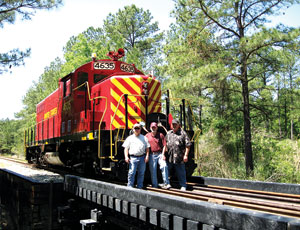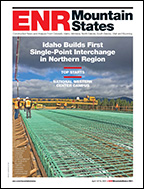Like any railroad crossing, the two short bridges completed this month at Fort Eustis, Va. will be expected to support 130 tons. Unlike typical crossings, however, they are made almost entirely of materials that once were used to contain milk and detergent.

Working with Rutgers University, Axion International Holdings Inc., New Providence, N.J., developed proprietary polymer formulas that combine plastics to make an end product tougher than its ingredients. Sales partner Innovative Green Solutions convinced the U.S. Army to try it, first on three bridges with pilings and I-beams made of plastic at Fort Bragg; two are completed, and one will be built this year. “We received ratings of 73 tons for track vehicles and 88 tons for wheeled vehicles,” says Axion CEO Jim Kerstein.
Design engineer Parsons Brinckerhoff, New York City, also had to be convinced. “My initial reaction was, what are we getting into?” recalls Vijay Chandra, PB senior vice president. “But this technology bodes well. Plastics in landfills never degrade. If we can re-use these sort of products, it helps everybody.” Lack of industry criteria posed a challenge, and issues of deflection and connections had to be solved, he says. But, he says, “If we can solve these issues with simple spans, then we can for continuous spans.”
Also commissioned by the Army, the 40-ft and 80-ft spans at Fort Eustis, Va., feature pilings and I-beams for pile caps and main girders as well as cross-ties and curbs made out of recycled plastic containers. Construction on the $1.3-million job took four months.
Plastic Takes a Pounding
As the 38-ft-deep plastic piles were driven, one pile hit substrata. “We pounded it 135 times, but it gave less than 3 in. It withstood 90 kips,” says Bart DeForest, senior project manager for Centennial Contractors Enterprises, Vienna, Va., the prime contractor. English Construction Co. Inc., headquartered in Lynchburg, Va., did demolition and construction.
DeForest says cost estimates for the plastic bridges beat a design with precast piles and steel girders because the need for a 200-ton crane was eliminated. “We got away with a 120-ton crane,” he says. Once past the learning curve, crews were able to install the plastic bridges several weeks faster as well, he adds.
The sight of plastic trash motivated Rutgers professors to begin working on the concept in the 1980s, Kerstein says. “[Research] evolved into how to go from a consumer product to an industrial product,” he says. Over time, pedestrian walkways graduated to vehicular bridges and now to railroads.
Chandra says more research and development is needed before the plastics can be used for Interstate bridges. “We’re still learning about this material,” he says. “The applicability depends only on the imagination.”
DeForest agrees: “It’s amazingly green. We removed 450 metric tons of greenhouse gas and 2,000 lb of postconsumer waste. There is a tremendous opportunity if people look outside the box.”



Post a comment to this article
Report Abusive Comment